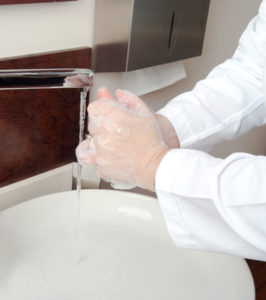In September 2017, the Organization for Safety, Asepsis and Prevention (OSAP) a growing community and membership association of clinicians, educators, policy makers, consultants and industry representatives who advocate for the Safest Dental Visit™, will celebrate the third annual Dental Infection Control Awareness Month (DICAM) to focus on the importance of infection control in dentistry.
 The unique nature of many dental procedures and settings makes it especially important that dentists and their staff adhere to specific strategies aimed at preventing pathogen transmission among themselves and their patients, according to the Centers for Disease Control and Prevention. Particularly in large group practices, which can have higher exposure and greater risk, it’s important to ensure that appropriate infection prevention protocols are practiced at each facility.
The unique nature of many dental procedures and settings makes it especially important that dentists and their staff adhere to specific strategies aimed at preventing pathogen transmission among themselves and their patients, according to the Centers for Disease Control and Prevention. Particularly in large group practices, which can have higher exposure and greater risk, it’s important to ensure that appropriate infection prevention protocols are practiced at each facility.
To promote patient safety and build patients’ trust in infection control compliance – and to reinforce its efforts to provide The Safest Dental Visit™ – the Organization for Safety, Asepsis and Prevention (OSAP) is gearing up for its third annual Dental Infection Control Awareness Month (DICAM) this September. In addition to creating awareness around infection control, the organization aims at helping the dental community “engage with each other and the public in an open, safe and collaborative dialogue,” says Christina Thomas, Senior Association Manager, OSAP.
Additional goals include supporting the CDC’s infection control checklist and championing the role of the infection control coordinator – a key staff member whose role it is to serve as a resource for the dental team in infection control and safety, and maintain oversight over the practice’s written exposure control plan, notes Thomas. “We fully support and promote the adoption of the CDC’s Summary and companion Infection Control Checklist and make this resource easily accessible to our members, partners and interested parties in support of the recommendations outlined in the CDC’s Guidelines for Infection Control in Dental Health-Care Settings–2003,” she says. “We also provide tools and resources on how to use this information to educate staff on OSAP.org and through training material such as OSAP’s implementation workbook, From Policy to Practice: OSAP’s Guide to the CDC Guidelines, updated in 2016. We work to support OSAP networks with access to this critical information in a variety of ways, including our annual observance of Dental Infection Control Awareness Month (DICAM).”
Supporting the ICC
The CDC recommends that every dental practice have an infection control coordinator (ICC), says Thomas. (For large group practices, many experts support having a designated infection control coordinator at each facility.) “The role of ICC is critical to help monitor compliance with regulations and spot possible gaps for review,” she says. For those interested in specifics on the role, OSAP provides information on the ICC’s main functions on OSAP.org, including:
- Lead in policy development, implementation and monitoring procedures using credible sources.
- Maintain relevant regulatory and guidance documents.
- Act as a resource on infection control/prevention for the team or organization.
- Maintain a basic understanding of products and equipment to maintain patient and provider safety.
Dental Infection Control Awareness Month will help us “communicate the importance of the role of infection control coordinator,” Thomas continues. “We’ve developed a few tools to help in this process, including the Case for Designating a Dental Safety Coordinator and Defining the Role of the Infection Control Coordinator.” OSAP also provides tools and resources for ICCs to educate them on CDC guidelines, complying with OSHA regulations, building a culture of safety and more, she adds. “We also encourage anyone involved in dental infection control safety to take advantage of OSAP membership to fully experience what this community has to offer.”
Open dialogue
When dental practices – both large and small – encourage a culture of safety and educate their patients about proper infection control protocols, “the end result can be a more positive and safe patient experience,” says Thomas. Therefore, “OSAP’s resources support positive messages to reinforce what the dental team does to keep patients safe.
“Having an open dialogue is important, and finding ways to spark this dialogue is also key,” she continues. “Dentists and their staff can promote Dental Infection Control Awareness Month through flyers and the resources we have available through DICAM tools. Having a poster or information posted in several areas of the office can serve as the catalyst for a positive conversation on infection control and safety.”
Dental Infection Control Awareness Month is just one way the dental community can get involved in ensuring every dental visit is a safe dental visit, Thomas points out. “The community of members, the events, access to products and updates on the latest emerging trends and research are a few more ways OSAP members are staying connected and having an impact on the future of dental infection control and safety,” she says. “There are many resources, as well as membership information, available on our website, OSAP.org. We encourage everyone to get involved and to make this September’s Dental Infection Control Awareness Month a successful one. It’s a topic that can’t be overlooked, because safety matters!”

